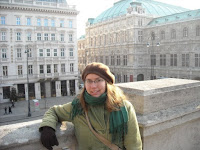 Saturday we hit up a grocery store, realizing the severity of our lack of food. We then hopped on the U-Bahn for the Belvedere. To get there we had to switch to the S-Bahn – Vienna’s equivalent of the RER – and thanks to some incompetency in reading signs we passed by the Prater theme park which allowed us to see the Ferris wheel featured in a dramatic scene between Joseph Cotten and Orson Welles in The Third Man.
Saturday we hit up a grocery store, realizing the severity of our lack of food. We then hopped on the U-Bahn for the Belvedere. To get there we had to switch to the S-Bahn – Vienna’s equivalent of the RER – and thanks to some incompetency in reading signs we passed by the Prater theme park which allowed us to see the Ferris wheel featured in a dramatic scene between Joseph Cotten and Orson Welles in The Third Man.
We eventually headed back in the right  direction and arrived at the Belvedere. Originally the summer palace of Prince Eugene of Savoy, it now hosts an impressive art collection. It understandably had an impressive selection of Klimts; although I don’t think I had heard of him before this trip, I grew to love the work of Gustav Klimt, pride of the modern Vienna art scene. The grand staircase and impressive rooms of both the Upper and
direction and arrived at the Belvedere. Originally the summer palace of Prince Eugene of Savoy, it now hosts an impressive art collection. It understandably had an impressive selection of Klimts; although I don’t think I had heard of him before this trip, I grew to love the work of Gustav Klimt, pride of the modern Vienna art scene. The grand staircase and impressive rooms of both the Upper and  Lower Belvedere buildings were also a treat. Plus, the French garden connecting them made me feel at home.
Lower Belvedere buildings were also a treat. Plus, the French garden connecting them made me feel at home.
We ended up passing our day amongst the art and stopped off to look at the beautifully lit Karlskirche [St. Charles’s Church] before heading home for the night.
On our last day in Vienna, we stopped by the Secessionist Building  whose art nouveau exterior was eye-catching and the Opera which was a bit of a rip-off of Paris’s Opera Garnier.
whose art nouveau exterior was eye-catching and the Opera which was a bit of a rip-off of Paris’s Opera Garnier.
We spent most of the day in the Albertina, yet another palace-cum-gallery, where a recently donated personal collection featured works by painters from Monet to Picasso and everyone in between (and even some after like Francis Bacon and Mark Rothko). A random smattering of contemporary Austrian art with poorly written – or poorly translated – accompanying text also held our attention. The Habsburg staterooms were equally thrilling, presenting the allure of a fully reconstructed timepiece with prints from Dürer and others decorating the walls. This mixture of luxury and art was particularly appealing to me. It’s like getting two attractions for the price of one!
After I bought some chocolates as a souvenir for my host mom, we began our search around the St. Stephen’s Cathedral for some “Viennese treats” to cap off our stay. Apparently I am spoiled from living in Paris where cafés line the streets and dot each corner, but it was harder than expected to find a suitable establishment. We did eventually locate this immense eatery where I had the milkshake I had been looking for all week and some tiramisu – don’t judge…it’s required to indulge while on vacation – and Ben got a classic apple strudel. Before saying goodbye to Vienna we took the U-Bahn out to Schönbrunn Palace, the Habsburg’s summer retreat, to snap some photos and stare. 
The next day, despite frustrations with the S-Bahn which decided to cancel a train making us wait on the cold quai [platform] for a good hour and ten minutes, we made it to the Vienna Airport and happily boarded our plane back to Paris.
 Lately I’ve been doing a lot of what my friend Zoë so elegantly called “carping the diem.” And by that I mean leaving the comfort of my room, getting out there and doing interesting things in this lovely city. This week I’ve had a lot of “Oh yeah, I’m in PARIS” moments so here’s a brief rundown:
Lately I’ve been doing a lot of what my friend Zoë so elegantly called “carping the diem.” And by that I mean leaving the comfort of my room, getting out there and doing interesting things in this lovely city. This week I’ve had a lot of “Oh yeah, I’m in PARIS” moments so here’s a brief rundown: 




 Saturday we hit up a
Saturday we hit up a 



















